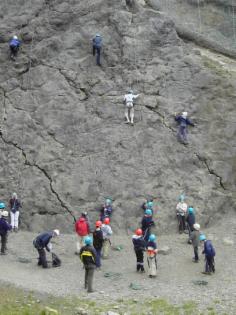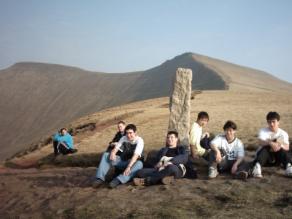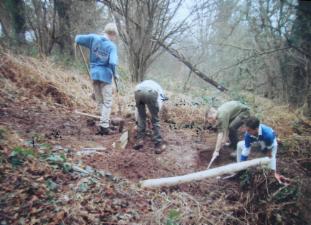Talybont - the Wilson's Connection:
Wilson's Field Centre in 1975 (built in 1911 as Talybont Mission Church and Hall, purchased 1970, sold on in 2009)
A Short History of Wilson's Field Study Centre, Talybont-on-Usk, Powys
Talybont Mission Church and Village Hall was built in 1911, to serve a growing farming and canal-side community in the Parish of Llandetty in the Brecon Beacons. It enjoyed some success between the two World Wars as a result of the influx of workers building Talybont Dam and Reservoir just up the Caerfanell valley, but as farming and local trade declined in the 20th century, so did church-going: services became less frequent and congregations dwindled. The Hall was still used for meetings and social events, but it had poor facilities, and with little Church or Community money available there was little prospect of improvement. The future did not look promising for Talybont‘s little Church and Hall by the late 1960’s, but at this point Wilson‘s Grammar School for Boys from Camberwell, South London, entered the frame. How and why did metropolitan Wilson‘s come to acquire the Old Church and Hall in rural Talybont?
National Park status for the Brecon Beacons in 1957 and the construction of the M4 Motorway and the Severn Bridge had made people in southern England increasingly aware of this relatively unspoilt mountainous area now less than four hours from London. Wilson‘s Grammar School had been holding very successful Summer Camps during the 1960s in remote parts of Highland Britain, settling for a while in North Wales, but in 1967 it became necessary to find a new venue at very short notice. The two Staff leaders drove down to the nearest part of Wales on the A40 one Saturday, and stopped for lunch, by chance, at the Usk Hotel in Talybont. They liked the look of the area, made enquiries straight away, and were offered a field backing onto the River Caerfanell alongside the old Church Hall. The Camp was so successful that they decided to make Talybont their base in succeeding years.
Talybont Village: the White Hart and the Canal
In 1969 the field flooded and they had to abandon their tents. They were invited to use the old Hall next door to dry out. The following year they hired the Hall as well as the field, only to learn that the building was to be sold. A brand new Community Centre with extensive playing fields had been completed in the village, and it was reluctantly decided that the old Mission Church and Hall was no longer needed. The two Staff Camp Leaders persuaded their hard-pressed Governors to make some money available, and they arrived in Brecon for the Auction with what seemed a totally inadequate bid, to find that they were the only bidders!
Inside the very plain timber-framed and iron-clad building, dark-stained panelling rose to a cavernous leaky roof in the chapel fronting the road, with a small rose window above a raised altar platform at the east end, and separated by a folding partition from the hall behind. The latter had a low stage with a small room on each side for access and storage. Heating was by means of primitive iron stoves, whilst small pointed windows and high dust-filled globes provided barely adequate light. The furniture was old wooden folding chairs, pews and cupboards. The 'kitchen' consisited of a prewar domestic gas cooker, a heavily scored wooden table, and a stone sink with the only water tap in the building (which was cold: hot water was produced laboriously in an old and dangerous copper boiler). Outside there was a small 'garden' adjoining the road, a small bell-tower on the roof, and a draughty shed which housed the only toilets. There were no wash basins or showers, and no beds.
Planning permission for conversion of the property to a mixed residential outdoor education centre was granted subject to the provision of off-road parking, proper catering facilities, and washrooms, which were only partly completed in time for the first Wilson's groups to stay during 1971 (provided by the local builder, J Lloyd Stephens, who just happened to be the Chairman of the Brecknock Planning Committee!). Within two years the basic conversion from Church Hall to Outdoor Centre was substantially complete, although improvements and modifications were ongoing. The costs of all this had to be met almost entirely by hiring out the facility when the School did not use it, while much of the labour and equipment was provided by teachers, parents and friends (see below). The School was also indebted to many well-wishers from the Talybont community, especially George and Lillian Burgess and Doris Curtis who were the original caretakers, cooks and cleaners, and their successors, neighbours Sarah Osborn, Sue Thorne and Glyn Thomas.
The Centre was popular with both Wilson's groups and ouside hirers right from the start, because of ite location and accessibility, its ambience, and its flexibility of use. Nearly all boys who passed through Wilson's in the next 35 years benefitted from visits to the Centre at least once in their school career. Most were keen to return, and some of them came many times over (see below for an outline of the different kinds of trips and activities provided).
First stop up the Caerfanell Valley: Talybont Dam and Reservoir,
The benefits were never meant to be entirely one way. The School always tried to ensure that all groups using the Centre did so responsibly, but it also encouraged the use of local facilities, organisations and expertise, and actively supported local initiatives. Ouside the present-day Community Centre in the village is an information board which acknowledges the many local and national contributions made to Talybont's 'Millenium Project', proudly announcing its completion and opening by the Lord Lieutenant of Powys in September 2000. Wilson's School is one of those contributors named: the boys rasied money for new equipment in the children's playground, they cleaned and painted street furniture in the village, helped to improve footpaths, to plant and protect trees, and to construct footbridges in the valley nearby. I represented Wilson's at the Opening Ceremony (one of the only outside organisation to accept the invitation), and on the strength of the goodwill generated I wrote and published booklets about Talybont, and developed this website.
At its peak in the 1980s and '90s the Centre was used up to 10 times a year by the School, as well as by at least as many outside hirers, but increasing administrative pressure on schools and outdoor recreational organisations caused a sharp decline in later years. Maintenance and Health and Safety issues became pressing, staffing of the Centre and Visits became a major issue, and there were insufficient funds available for the improvement work deemed necessary. Sadly, in 2008 the School Governors decided that the old Hall was to be sold off once again.
Any thoughts, or memories? contact me by email
MK retrieving fieldwork resources from the Field Centre;
Trips and Activities:
Wilson's Summer Camps (1967-1987): Annual voluntary visits under canvas at the end of each Summer Term, based on Outdoor Pursuits such as canoeing, rock climbing, pony-trekking, orienteering and hill walking, with lightweight camping expeditions in small groups, and individual outdoor projects based on visits to sites in the surrounding area. Later on, caving and sailing were added for senior boys. It was at Camp that some long-standing traditions became established: softball before dinner on the old School field down the road, and table-tennis in the Hall; `Base Camp Groups` laying tables, peeling spuds and washing up; everyone making packed lunches before breakfast; bedtime readings and stories (especially the legendary `Story of Little Tommy Jones`). The Camps had been run from pre-Talybont years by Norman Sollis and Malcolm Prentice (the staff who instigated the Field Centre purchase), while their wives did the catering. I was introduced in 1971; other Staff, families and Old Boys also joined in, but had to make their own contributions as the Camps were entirely self-financing, and charges to the boys had to be kept to a minimum.
Second Form Trips (1971-2007): Week-long residential trips in term-time for whole Forms, using the Summer Camp experience, but with a pastoral and curricular emphasis. The Activities were mainly field studies in Archaeology, Biology, and Geography, reflecting the teaching interests of the leaders (Norman, Malcolm and me), the curricular requirements of the subjects, and the opportunities presented by the area and its environment. There was no camping (we had the Hall by then) and the catering was done by two ladies from the village; the boys did the necessary chores in groups, as at Camp. The activities for each day were written up each evening, and included castles and museums, field study techniques, data collection, sketching, questionnaires and worksheets, and so on. Map and Compass instruction and climbing Pen y fan were usually included, and, later on, visits to the spectacular caves and waterfalls in the Vale of Neath, and Big Pit Coal Mine. Prizes were awarded on Speech Day for the best Talybont Projects.
Exploring Blaen y glyn Waterfall
From 1996 they became Year Seven Trips, shortened to four days including travelling: a local orienteering walk, one day gorge walking and rock climbing in the Vale of Neath, and one morning climbing Pen y fan, before going underground at Big Pit near Blaenafon in the afternoon.

Y7 Rock climbing at Dinas Rock
`A` level and GCSE Field Classes (1971-2007): The very first Wilson's School use of the Hall at Talybont after its purchase was jointly by Ken Daynes for CCF Outdoor Training and Malcolm Prentice for Sixth Form Biology Fieldwork (Easter 1971, just one week before I joined the Staff). I held the first `A` Level Geography Field Class jointly with Malcolm and his Biologists the following spring, a very fruitful collaboration that lasted many years.
Direct observation and recording in the field, supplemented by maps and photographs, have always been my preferred methods of teaching and learning, and the opportunities the Talybont Field Centre promised were one of the main reasons that I took the Head of Geography post at Wilson's. I had acquired considerable knowledge and experience of field techniques while at school, at university, and in my previous teaching post, but I had very limited direct knowledge of South Wales and the Brecon Beacons when I arrived. I was therefore initially dependent for suitable fieldwork topics and locations on what I had read, what I learnt from Malcolm Prentices's initial forays in Biology, and what I saw at my first Summer Camp. However, such was the location and environment of the new Field Study Centre, that there was a wealth of options on offer, and many of my initial choices of sites and topics continued (albeit with modification) right through into the post-Field Centre era. These have included land use and hydrology in the Caerfanell valley, settlement patterns around Brecon and Abergavenny, glaciation in the Brecon Beacons, industrial development in the South Wales Coalfield, coastal landforms and processes in the Gower Peninsula, and comparative soil and vegetation surveys at various locations. Other worthwhile exercises quickly followed, eg rocks, slopes and drainage in the Vale of Neath, recreation in the Beacons National Park, urban morphology in Merthyr Tydfil and Ebbw Vale, and water treatment and pollution at Llangorse Lake and Taff Vale. More recently, Abergavenny's sphere of influence, the Port Talbot Steelworks, land reclamation in the Swansea Valley, and sand dune morphology at Kenfig Burrows and Port Eynon have loomed large. Some of these exercises were submitted as part of the students' public examinations, and were always highly graded.
The entrance to Porth yr ogof Cave.
In addition to 'A' Level Field Classes I initiated long weekend 4th and 5th Form
Field Classes for GCE Geography and GCSE Physical Environment courses. These included some of the same locations and topics as for `A`Level, but there were also some pioneering exercises too, such as large-scale Group Transects across the Beacons and in the Rhondda Valleys, a superstore decision-making exercise in Blaenau Gwent, and a comparison of rates of erosion on footpaths and in streams above Blaen y glyn..
Outdoor Pursuits and Conservation Weekends: Before 1995 Outdoor Pursuits were mostly offered as part of Summer Camp, which put them out of reach of many boys (although most visits to the Brecon Beacons inevitably involved some hill walking, and I did organise occasional Hill Walking and Outdoor Activity Weekends for boys, Parents, and Staff - see below). But when I retired from classroom teaching in 1996, I was offered a unique `Talybont Co-ordinator` post whereby I could organise and lead as many Talybont Visits as I wanted (and could staff!), as well as managing the Centre and arranging Lettings. I immediately went to my last Year 7 Form (who had only just returned from their Talybont Form Visit with me), and asked them if they were interested in an Outdoor Activity Weekend that coming autumn. The result was a resounding `yes, please`, and I made arrangements straightaway. I drove down with 26 boys and 2 other staff after school one Friday in September, and we immediately walked round Blaen y glyn Waterfalls by torchlight, which was a magical start. We went up Pen y fan by the ‘Tommy Jones’ route on the Saturday, and visited the caves at Porth yr Ogof and the Beacons Mountain Centre on Sunday, before driving home in the evening. The boys played games on the Field before Saturday's meal, and table-tennis in the Hall afterwards; they had a bedtime story (by popular demand), and time to do homework (to placate colleagues back at school). The trip was an outstanding success, and the boys asked if they could go again soon, this time to do Outdoor Pursuits – rock climbing and gorge walking, mountain biking and canoeing. That we did, and the die was cast – I was to organise three or four of these Talybont Activity Weekends for all age-groups every year for the next eight years. Several of the boys from my old Form made up the core group on each trip as they went up through the School – they couldn’t get enough of it! Their appetite for new Outdoor Activities extended to caving, D of E expeditions, night hikes and wide games, bivouacking under the stars, a firework party (at Blaen y glyn, which confused some soldiers on a training exercise!), and successful participation in a national all-age Orienteering Competion in the Forest of Dean. (In the Sixth Form a group of these same boys organised their own 3 week walking and climbing expedition in the Alps, so hooked were they!)

6th Form at Tommy Jones' Obelisk, Penyfan & Corn Du beyond.
In 1998 Raleigh International asked if they could use our Centre as a base for some work they were doing as part of Talybont Community Council’s Millenium Project improving pedestrian access in and around the village. I saw an opportunity for new activities for our boys, and a chance for Wilson’s to put something back into the community. Our boys (mostly Years 9 to 11) so impressed the Raleigh staff and volunteers that they invited us to join in again the following year. Back at School the boys raised money towards some new equipment for a children’s playground which was installed in time for the celebratory Opening Ceremony in September 2000.
I arranged several more Conservation Weekends in the National Park for older boys and Staff, many of whom had not been to Talybont before. We repaired footpaths, dismantled one footbridge and replaced another, planted new trees and cut back old ones, diverted a stream, cut and burnt gorse and heather to improve wildlife habitat, built and repaired fences and stiles, painted the bus shelter in the village, and varnished commemoration seats by the Canal. I made a point of fitting in at least one recreational activity or hill walk on each Conservation Weekend, the highlight of which was undoubtedly in June 2003: we climbed Pen y fan overnight to view the Midsummer sunrise over the Black Mountains - yet more magic!

Y9 renovating a footpath on a Conservation Weekend.
PTA Working and Walking Weekends (1975-2003): These stemmed from the inauguration of Wilson's Parent Teacher Association when the School moved to Sutton in 1975. The newly-elected Committee wanted to see for themselves the Field Centre that their sons had visited and talked about. A PTA Walking Weekend was organised by myself, Malcolm Prentice and Ken Daynes which enthused them so much that they pledged fund-raising support and expertise in building, supply of equipment, and maintenance. Working Weekends (with a bit of Walking and Socialising) were then organised at least once a year, intitially directed by Malcolm, then by Mary Jones, who was both a parent and the Biology lab technician at School. They were responsible for much of the early conversion work from dowdy Church Hall to the welcoming and flexible Field Outdoor Centre it became - bunk beds and matresses, cupboards, furniture and carpets, washrooms and showers, kitchen equipment, gas central heating, hot water, rewiring, staff bedrooms, notice boards, loft storage, the garage store, outside painting and redecoration were all largely provided by PTA volunteers: even older pupils helped out.
Any thoughts or memories to share? I would be glad to receive them via email:
martindknight@gmail.com